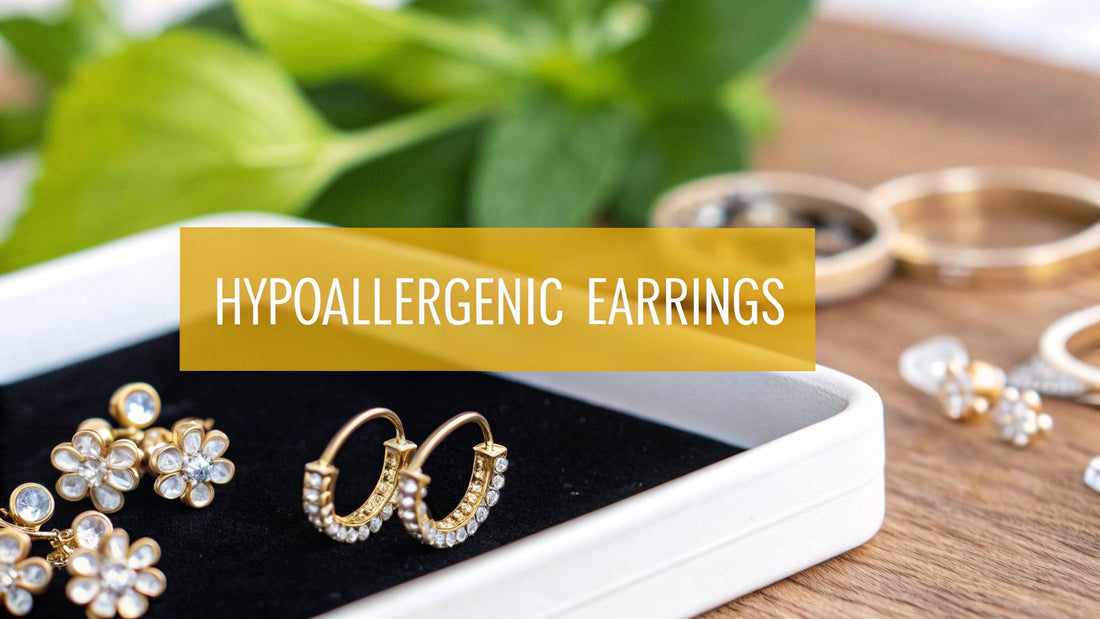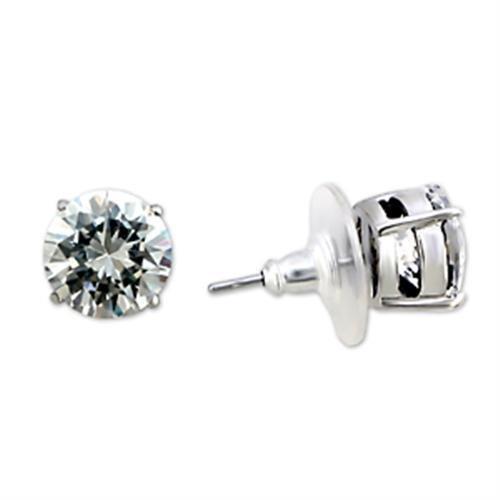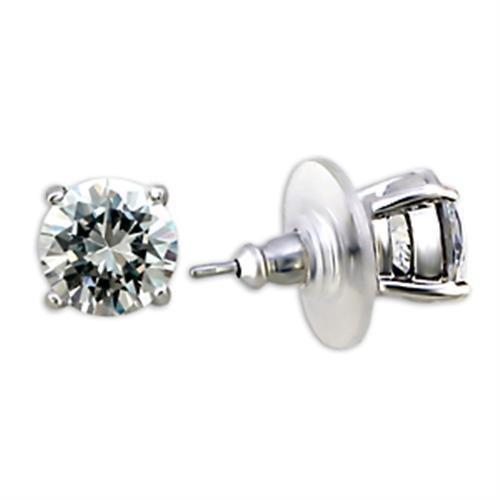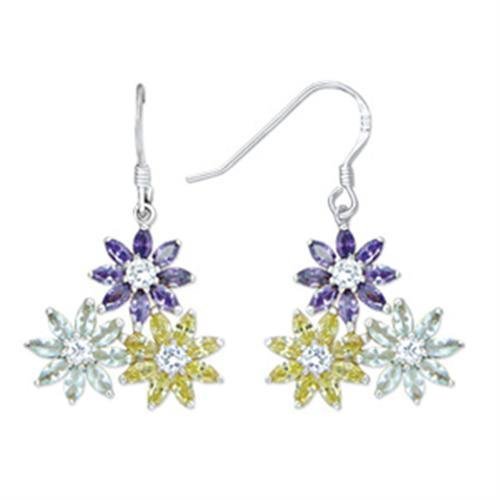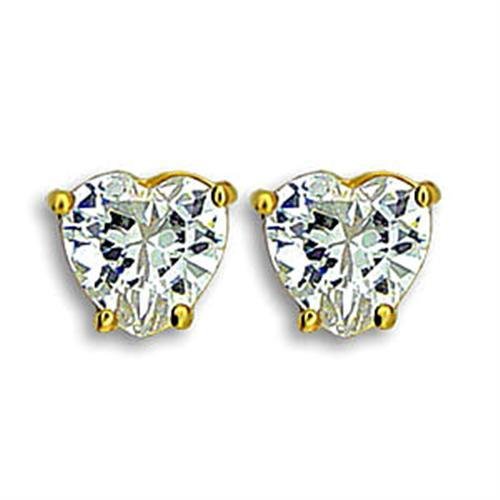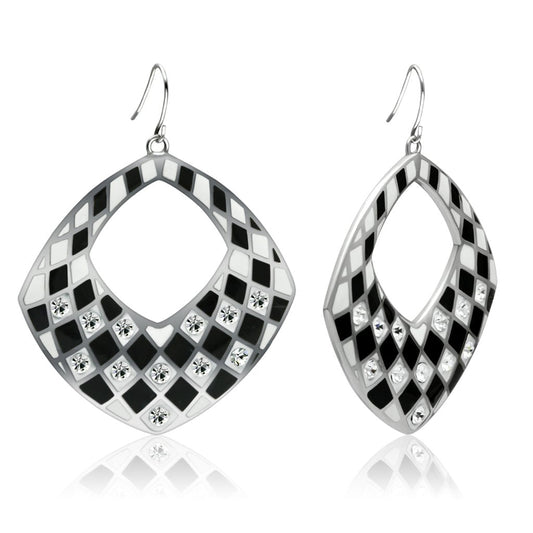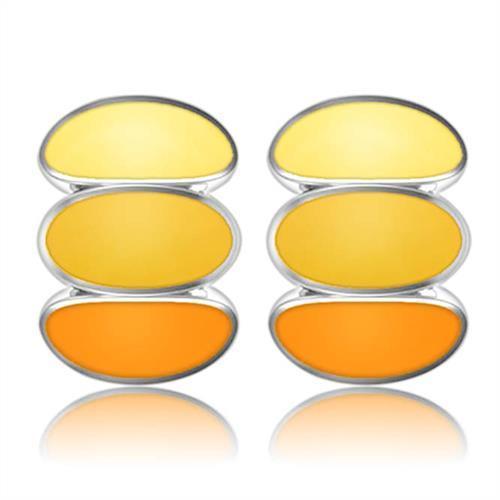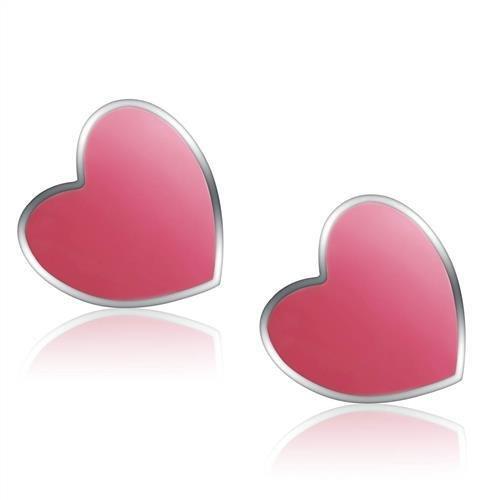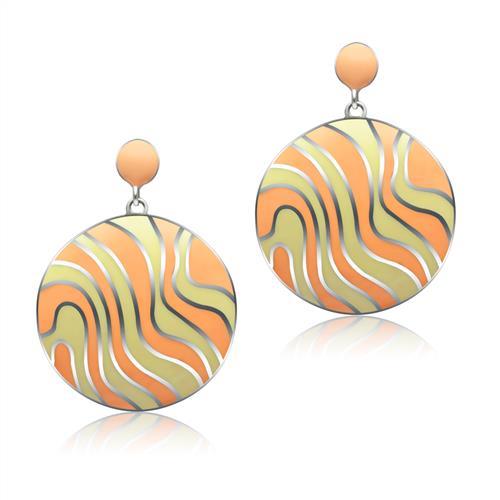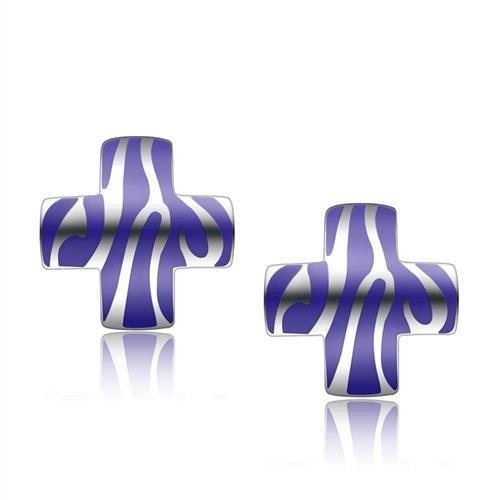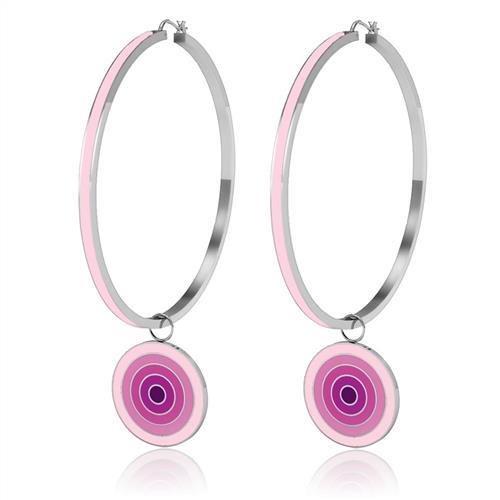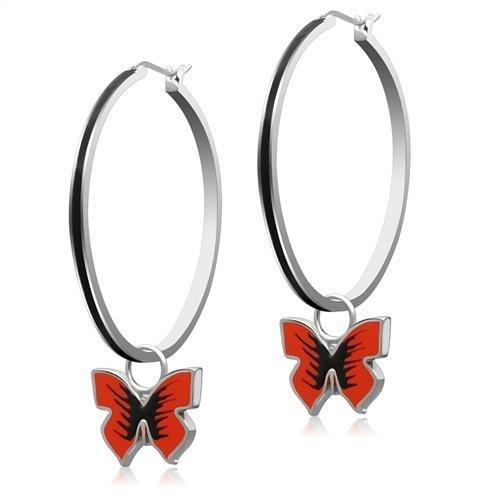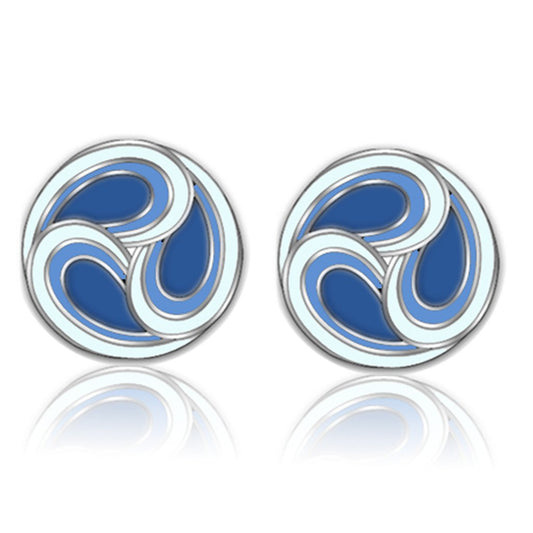Got a jewelry box full of beautiful earrings you’re too afraid to wear? You find the perfect pair, put them on, and hours later your earlobes are red, itchy, and sore. It’s a frustrating cycle of choosing between style and comfort that so many people know all too well.
The good news? The solution is simpler than you think. The problem almost always comes down to one hidden culprit: the metal. By choosing the right material, you can finally wear beautiful earrings without irritation.
Your Quick Guide to Irritation-Free Earrings
Many mass-produced fashion earrings are made with alloys containing nickel, a notorious irritant that triggers reactions in up to 20% of the population. When your skin comes into contact with it, your immune system can overreact, leading to the redness, itching, and swelling of contact dermatitis.
The secret to breaking this cycle and finally enjoying beautiful earrings is choosing the right material. The best earrings for sensitive ears are made from biocompatible, nickel-free metals that your body won't see as a threat. Think of materials like implant-grade titanium, surgical steel, and pure 14k+ gold. Getting this one step right is the most important thing you can do for happy ears.
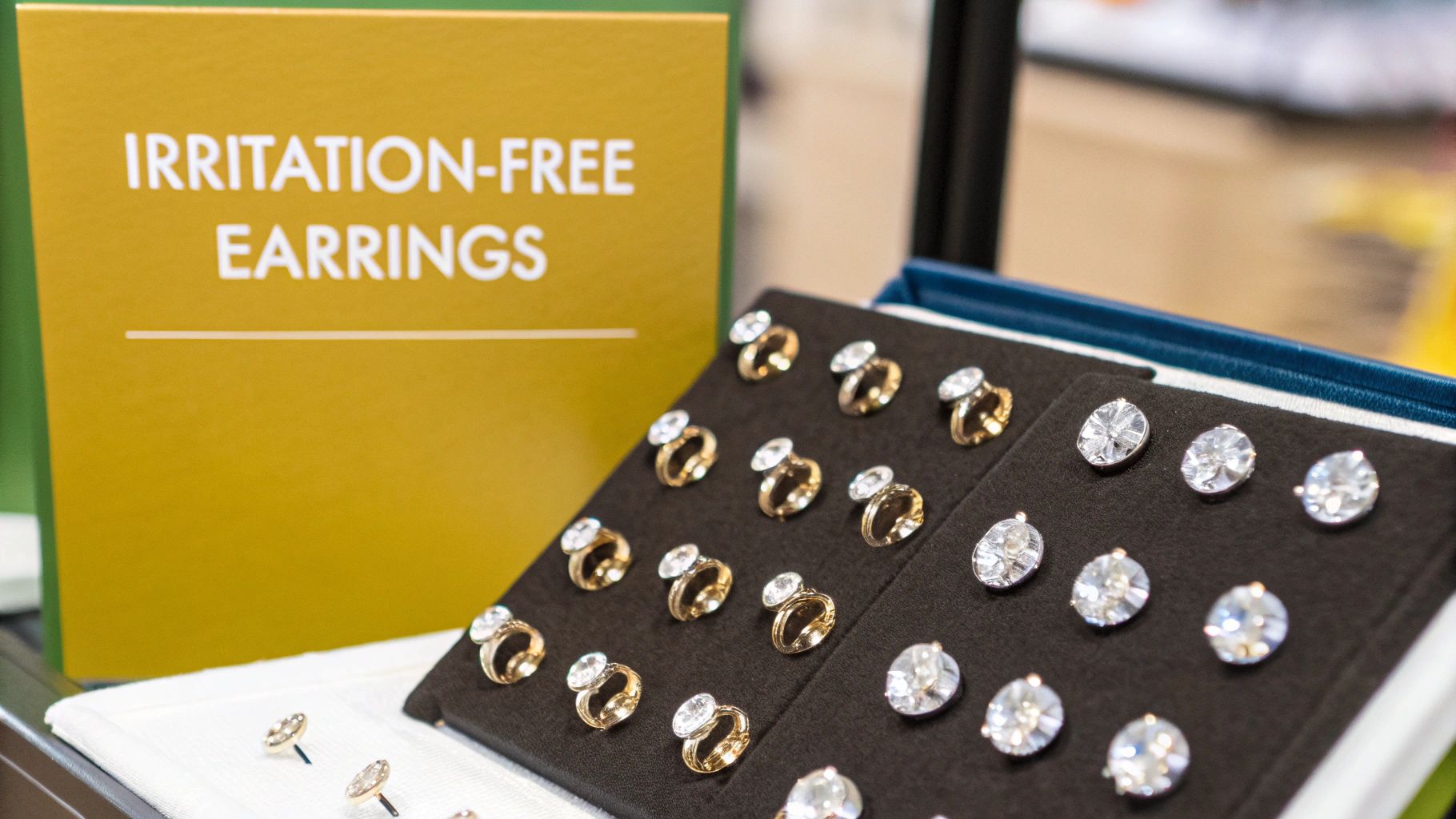
Finding Your Safest Metals
To avoid discomfort, the key is to look for hypoallergenic metals. These are materials that are naturally pure and free of the common allergens that send your skin into a frenzy.
Think of this as your cheat sheet for happy ears. Understanding these options is the first step toward building a collection of stunning, irritation-free earrings you can actually wear all day, every day.
"True hypoallergenic earrings should be made from materials that are naturally non-reactive with human skin or crafted by brands that specifically engineer their pieces to avoid common allergens."
This is a crucial distinction. Just seeing "hypoallergenic" on a label isn’t enough. Knowing which materials are genuinely safe empowers you to shop smarter. So, let’s look at the best options out there.
Top Hypoallergenic Earring Materials at a Glance
To help you shop with confidence, here is a quick overview of the top hypoallergenic metals.
| Material | Key Benefit | Best For |
|---|---|---|
| Titanium | Completely nickel-free and lightweight | Extremely sensitive skin and new piercings |
| Niobium | Highly biocompatible and comes in many colors | Those with severe metal allergies |
| Surgical Steel | Durable, affordable, and corrosion-resistant | Everyday wear and moderate sensitivities |
| 14k-18k Gold | Classic look with low risk of reaction | Timeless style and mild to moderate sensitivities |
| Platinum | Extremely pure and durable | Investment pieces and very sensitive skin |
By getting familiar with these top-tier materials, you can finally end the guesswork. You no longer have to sacrifice style for comfort.
Instead, you can focus on finding beautiful designs from trusted brands like Precious Pulse Jewelry that prioritize high-quality, skin-friendly metals. This guide will walk you through everything you need to know, starting with why your ears react in the first place.
Why Your Ears React to Certain Earrings
Ever put on a gorgeous new pair of earrings, only to end up with red, itchy, and swollen earlobes a few hours later? It’s a frustratingly common experience, and it's enough to make you swear off jewelry for good. But that discomfort isn't just a random annoyance—it’s your body sending you a very specific signal. Understanding that signal is the first step to finally wearing earrings you love without the pain.
The main culprit behind this misery is usually a nickel allergy. It's one of the most common forms of allergic contact dermatitis, affecting a huge portion of the population and turning a simple accessory into a real source of irritation. When you wear earrings containing nickel, your body’s immune system can mistake the metal for a harmful threat.
Your Body's Faulty Security System
Think of your immune system as a super-advanced security system that’s programmed to protect you from legitimate dangers like bacteria and viruses. But for people with a nickel allergy, that system has a tiny glitch. It incorrectly flags the harmless nickel particles as dangerous intruders.
This false alarm triggers a full-blown defense. Your body floods your earlobes with inflammatory cells to fight off the "invader," which leads to all those classic symptoms: redness, swelling, itching, and sometimes even blistering. It’s not the earring attacking you; it’s your own body’s overprotective response.
Allergy vs. Sensitivity: What's the Difference?
It’s also helpful to know whether you’re dealing with a true allergy or just a general sensitivity. They can feel similar, but what’s happening beneath the surface is quite different. Pinpointing which one you have will make choosing the right earrings a whole lot easier.
- An allergy is a true immune system response, just like that faulty security system we talked about. It often develops over time with repeated exposure and triggers a consistent, predictable reaction to a specific metal—usually nickel.
- A mild sensitivity, on the other hand, is more of a localized skin irritation. It might be caused by the friction from a heavy earring, the sharp edge of a post, or even a buildup of bacteria from not cleaning your earrings often enough. It's uncomfortable, but it doesn't involve the same all-out immune system attack.
This infographic breaks down the two main reasons your ears might be acting up.
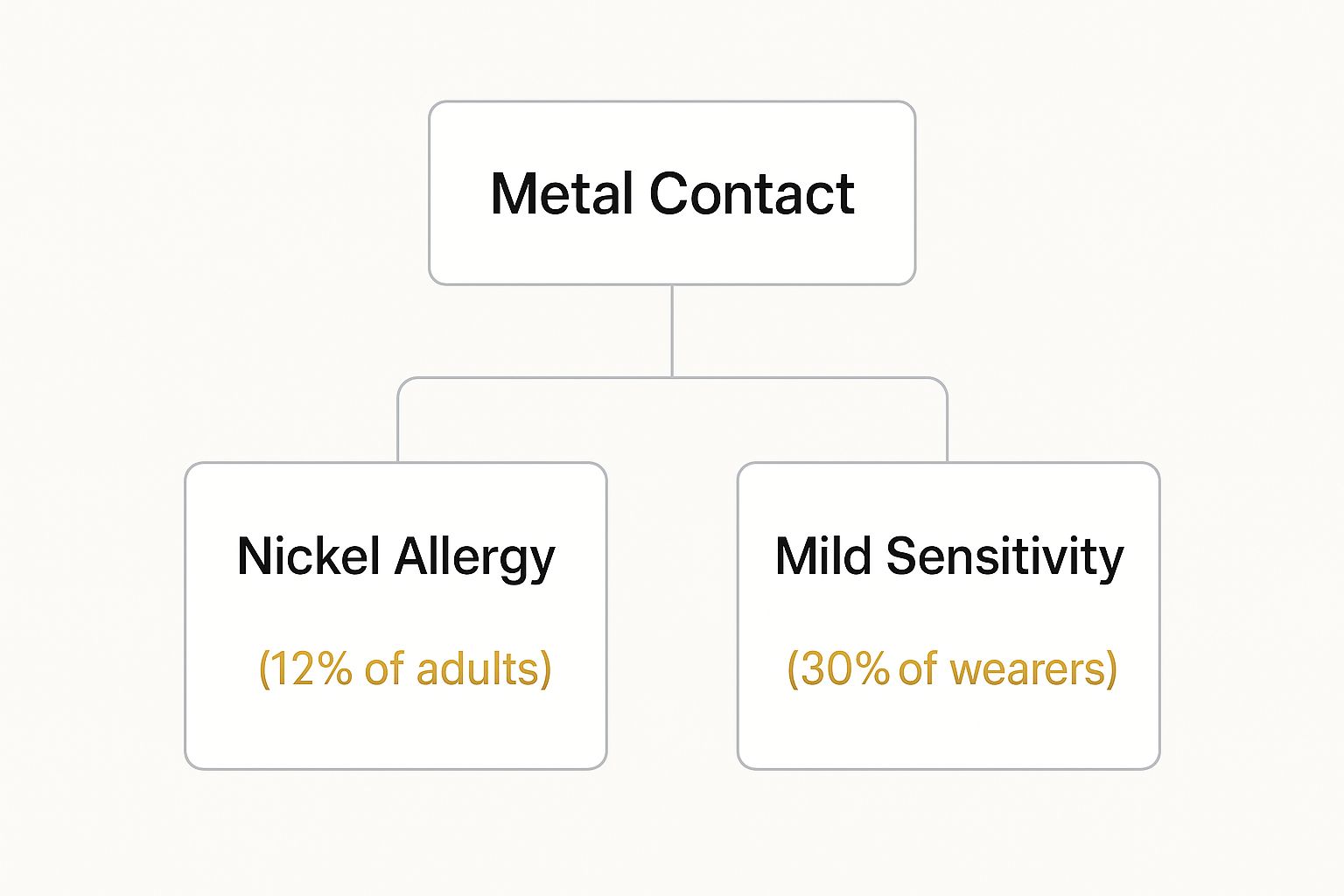
As you can see, a huge number of people deal with either a true nickel allergy or a more general sensitivity, so if this is happening to you, you're definitely not alone.
Knowing the 'why' behind the itch is empowering. It changes you from a frustrated jewelry wearer into a savvy shopper who can confidently pick out safe, comfortable, and beautiful earrings.
When you understand the root cause of the irritation, you can make smarter choices. Avoiding the trigger—usually nickel—is the most effective way to prevent a reaction and enjoy your accessories without pain.
For instance, if you react to pretty much any pair of low-cost fashion earrings, you probably have a nickel allergy. But if you only get sore after wearing heavy dangles all day, it might just be a mild sensitivity. Either way, the solution is the same: choose jewelry made from high-quality, biocompatible metals. Let's dive into which materials are your safest bet.
A Definitive Guide to Hypoallergenic Metals
Navigating the world of jewelry when you have sensitive ears can feel like walking through a minefield. One wrong choice, and you're left with painful, irritated lobes. The secret to ending this cycle for good is learning to speak the language of metals.
Think of this as your personal cheat sheet for confident, pain-free earring shopping. We're going to dive deep into the top-tier hypoallergenic metals—titanium, niobium, surgical steel, gold, and platinum—so you can finally build a collection you love to wear, without a second thought.
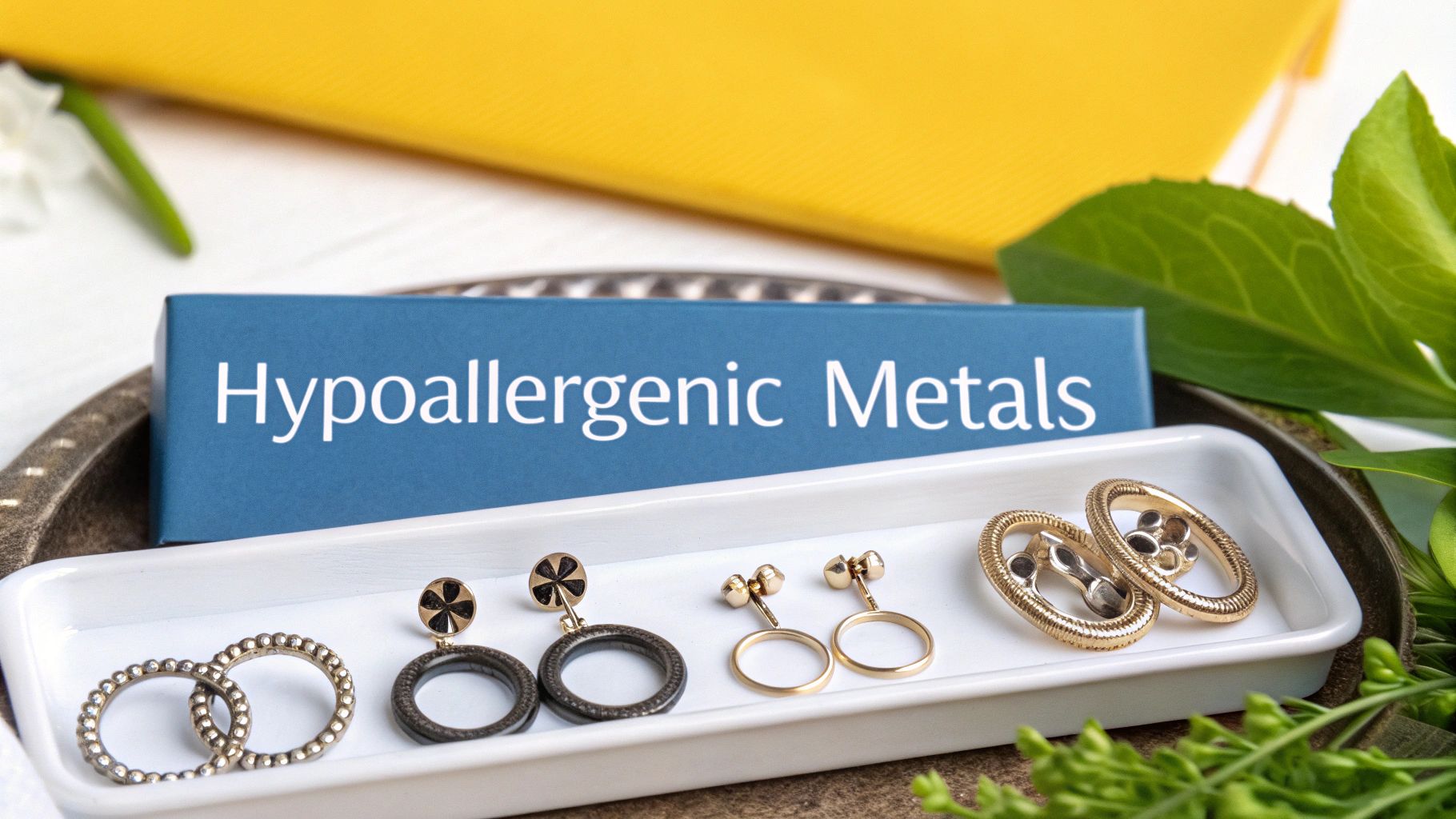
Titanium: The Medical-Grade Champion
If your ears react to almost everything, consider titanium your new best friend. It’s a true powerhouse in the hypoallergenic world because it is 100% nickel-free. That’s not a marketing claim; it's a fundamental property of the metal itself.
Titanium is so biocompatible that it's the go-to material for medical implants like joint replacements and dental screws. Your body simply doesn't recognize it as a foreign invader, which means no inflammatory attack on your earlobes. It's also shockingly lightweight, making it one of the most comfortable choices for all-day wear.
Pros of Titanium:
- Completely Biocompatible: The absolute safest option for severely sensitive skin and brand-new piercings.
- Feather-Light Comfort: You’ll honestly forget you’re even wearing earrings.
- Exceptional Durability: It resists scratches and corrosion like a champ, so it’s built to last a lifetime.
Cons of Titanium:
- Higher Price Point: Its purity and strength mean it costs more than materials like surgical steel.
- Limited Shine: It has a slightly darker, gunmetal-like finish, not the bright polish of platinum or silver.
Niobium: The Colorful and Safe Alternative
A close cousin to titanium, niobium is another fantastic choice for those with extreme metal allergies. It's a pure elemental metal, which means it contains zero nickel, lead, or other common irritants. Just like titanium, it’s highly biocompatible and often used in medical devices.
But here's where niobium really stands out: its ability to be anodized. This cool process uses electricity—not paint or plating—to create a stunning rainbow of iridescent colors. This makes it a perfect option if you love vibrant jewelry but need a material that won't betray your sensitive skin.
Surgical Steel: Understanding the Grades
Surgical steel is one of the most popular materials for hypoallergenic jewelry, but it’s critical to know what you're actually buying. The term can be a bit of a catch-all, and not all surgical steel is created equal. The trick is to look for specific grades that are safe for long-term body contact.
The two most common grades are 316L and 316LVM. While both are considered "surgical grade," they do contain a small amount of nickel. The key is that it's chemically bonded within the steel, making it far less likely to leach out and cause a reaction for most people. However, if you have a severe nickel allergy, you might still run into trouble.
For maximum safety, always look for implant-grade surgical steel (ASTM F-138). This is the exact same material used for permanent medical implants and has the lowest possible nickel release rate, making it the safest steel option out there.
To get an even deeper look into what makes jewelry truly safe for sensitive skin, you can learn more about what "hypoallergenic" really means in our detailed guide. Knowing the lingo is the first step toward making choices that keep your ears happy. Check out our guide on what hypoallergenic jewelry really is.
Gold: The Classic Choice with a Twist
Gold is a timeless, beautiful choice, but its suitability for sensitive ears comes down to one thing: its purity, or "karat." Pure, 24k gold is far too soft for earrings, so it has to be mixed with other metals (alloys) to make it strong enough for daily wear. The problem? Those other metals often include nickel.
This is where understanding karats is essential for avoiding a reaction.
- 14k Gold: This is often the sweet spot. It's made of 58.3% gold and 41.7% other alloys like silver and copper. High-quality 14k gold is frequently made to be nickel-free, making it a safe and durable choice.
- 18k Gold: At 75% pure gold, this is also a great option. It's a bit softer and more expensive than 14k, but the lower alloy content further reduces the risk of a reaction.
- 10k Gold: This blend contains only 41.7% gold, meaning there’s a much higher percentage of other metals, which dramatically increases the risk of a nickel reaction. It's best to steer clear if you have known sensitivities.
The demand for hypoallergenic earrings has shot up recently, as more of us become aware of skin sensitivities. By 2025, the ear accessories market is projected to be worth a massive $15 billion, growing at a Compound Annual Growth Rate (CAGR) of 7% from 2025 to 2033. A huge part of that growth is a focus on safe materials like surgical steel and 14K gold plating, which are top recommendations for sensitive ears. You can dig into more insights about the growing ear accessories market on archivemarketresearch.com.
Platinum: The Pinnacle of Purity
Finally, we have platinum—the undisputed king of hypoallergenic metals. It is one of the purest, densest, and most durable precious metals you can find for jewelry. Platinum is typically 95% pure, with the remaining 5% made up of other non-irritating metals.
Because of this incredible purity, platinum is naturally nickel-free and one of the absolute safest choices for anyone. It's heavy, durable, and has a gorgeous bright white luster that will never fade or tarnish. Of course, this premium quality comes with a premium price tag, making it a true investment piece for your collection.
How Earring Style and Weight Impact Comfort
Picking the right hypoallergenic metal is a huge first step, but it’s only half the battle. The actual design of an earring—its weight, shape, and even the type of backing—plays a massive part in how it feels hour after hour. Even a pure titanium earring can cause irritation if it's too heavy or poorly designed, proving that finding the best earrings for sensitive ears means looking at the whole picture.
It’s a bit like buying shoes. The most breathable, high-quality leather won't save you if the shoe is too heavy or pinches your heel. In the same way, even the safest metal can lead to discomfort if the earring's design puts unnecessary strain on your earlobe.

Why Weight and Shape Are So Important
Those gorgeous, heavy, dangling earrings are stunning for a night out, but they can be a real source of trouble for daily wear. The constant downward pull can stretch your piercing, leading to soreness and inflammation over time. This is a physical strain—a mechanical irritation that has nothing to do with a metal allergy but feels just as miserable.
For everyday wear, lightweight styles are always the better choice. They keep physical stress to a minimum, letting your piercings stay happy and healthy.
- Stud Earrings: These are the gold standard for sensitive ears. Their simple design sits right against the lobe, so there’s no pulling or tugging. They are perfect for 24/7 wear.
- Small Hoops or Huggies: These are also a fantastic option because their weight is spread evenly around the piercing instead of creating a single pressure point.
- Statement Earrings: Save the heavier, more dramatic styles for special occasions. Think of them as special-event shoes—wear them for a few hours, then give your ears a break.
If you love the look of bold jewelry but not the pain, you can explore collections of the best lightweight earrings for all-day comfort to find stylish, feather-light alternatives.
A Guide to Earring Backs
That tiny piece that holds your earring in place is just as critical as the part everyone sees. A poorly designed back can poke you, trap bacteria, or squeeze your earlobe too tightly. Knowing the difference between the types can help you find the most comfortable and secure fit.
Key Takeaway: The earring back is all about security and comfort. A good one prevents poking (especially when you're sleeping), keeps the earring from pinching your skin, and ensures it stays put.
Beyond just the metal, the design of the earring back itself can make or break your comfort. If you want to go deeper on this, you can learn why flat back earrings are an excellent choice for sensitive ears and see why they've become so popular.
Here's a quick rundown of the most common earring backs:
| Backing Type | Pros | Cons |
|---|---|---|
| Butterfly Backs | Common, easy to use, and inexpensive. | Can trap gunk; posts can poke you behind the ear. |
| Screw Backs | Extremely secure, ideal for valuable earrings. | Can be a pain to put on; threads might irritate some. |
| Flat Backs | The ultimate in comfort; no poking from the post. | Can be trickier to insert; often cost a bit more. |
| Lever Backs | Secure, elegant, and simple to wear. | Mostly used for dangle or hoop style earrings. |
For maximum comfort, especially if you have cartilage piercings or wear your earrings 24/7, flat backs are often the top choice. Their smooth, disc-like backing sits flush against your skin. This completely eliminates that dreaded poke from a traditional post when you're sleeping or talking on the phone.
Proper Care for Healthy and Happy Piercings
Finding the perfect pair of hypoallergenic earrings is a huge win, but that's just the first step. The real secret to long-term comfort is keeping those earrings—and your piercings—clean. Proper care prevents the buildup of bacteria, oils, and skin cells that can cause trouble, even with the safest metals.
Think of your piercing as a tiny, delicate tunnel. Anything left behind, from soap residue to your skin's natural oils, can become a source of irritation. A simple, consistent cleaning routine is your best defense for keeping your earlobes healthy, calm, and ready for your favorite styles.
This isn't about complicated procedures or pricey products. In our experience, the most effective methods are often the simplest ones that gently work with your skin, not against it.
Creating a Gentle Cleaning Routine
The key here is consistency and using the right tools for the job. Harsh chemicals can be just as problematic as the wrong metal, stripping your skin of its protective oils and leading to dryness and irritation. Your goal is to gently cleanse, not to blast the area with abrasive products.
For daily upkeep, a gentle touch is always the best approach. You don't need to be aggressive to be effective.
Your Go-To Cleaning Toolkit:
- Saline Solution: This is the gold standard for a reason. A simple sterile saline wound wash (you can find it at any pharmacy) is perfectly pH-balanced and mimics your body's own fluids, making it incredibly gentle and effective.
- Mild, Fragrance-Free Soap: A basic soap without any added dyes or perfumes works beautifully. Just lather it with warm water, gently cleanse the piercing, and—this is critical—rinse thoroughly to make sure no residue is left behind.
Important Reminder: Steer clear of rubbing alcohol, hydrogen peroxide, or antibacterial ointments. These products are far too harsh for a piercing. They often kill off healthy cells, which can delay healing or lead to severe dryness and irritation.
Sticking to these gentle options supports your skin’s health. Of course, some metals need a little extra TLC to stay looking their best. To learn more, check out our helpful guide on how to properly care for sterling silver jewelry and keep it shining.
Managing a Flare-Up
Even with the best care, you might run into a little redness now and then. Maybe you wore a heavier pair of earrings for too long or forgot to clean them for a few days. If you notice some soreness or redness, don't panic.
First, take the earring out to give your ear a much-needed break. Clean the piercing with your saline solution twice a day and just let it breathe. It's often best to leave the piercing empty for a day or two until the irritation calms down.
Once your ear feels better, you can reintroduce a known safe, lightweight stud made from titanium or surgical steel. This helps keep the piercing open without adding any more stress.
When to See a Professional
While most minor irritations are easy to manage at home, some signs are red flags that it's time to call in a professional. Trying to self-treat an infection can make things much worse.
Consult a Doctor or Professional Piercer if You Experience:
- Thick, yellow, or green discharge
- A piercing that feels hot to the touch
- Severe swelling or redness that seems to be spreading
- A fever or just generally feeling unwell
These symptoms could point to an infection that requires medical attention. A professional can give you the right advice to get your piercing back on track safely. Taking these steps seriously is what ensures you can enjoy your collection of the best earrings for sensitive ears for many years to come.
How to Shop for Genuinely Hypoallergenic Jewelry
Walking into the jewelry world can feel like a minefield, especially when one wrong choice leads to a week of painful, itchy ears. "Hypoallergenic" gets thrown around a lot, but what does it actually mean? With so much misleading marketing out there, it’s easy to feel lost.
The goal here is to help you become a confident, savvy shopper. Think of it like reading the label on a food package when you have an allergy. You wouldn't just trust a box that says "healthy"—you'd flip it over and scan the ingredients. We're going to do the same for earrings.
This skill is more important than ever. In North America, shoppers are increasingly looking for high-quality and designer earrings, which pushes brands to use better materials that won't irritate sensitive skin. It’s a trend driven by a growing awareness of skin safety and a simple desire for jewelry that’s both beautiful and comfortable. You can dive deeper into this shift in this global earring market report from dataintelo.com.
Decoding Product Descriptions
The secret is in the details. A reputable brand will be proud to tell you exactly what's in their jewelry. Vague language? That’s almost always a red flag.
Green Flags (What to Look For):
- Nickel-Free: This is the magic phrase. It’s a direct promise that the number one culprit for skin reactions is nowhere in sight.
- Implant-Grade Titanium (ASTM F-136): This is the good stuff—the same top-tier titanium trusted for medical implants. It doesn’t get much safer.
- 316L Surgical Steel (ASTM F-138): This specific grade is the implant-quality version of surgical steel, with an extremely low nickel-release rate that’s safe for most.
- Solid 14k Gold or 18k Gold: The word "Solid" is key. It means there’s no mystery base metal hiding underneath a thin plating, waiting to cause a reaction.
- Pure Niobium or Platinum: Seeing these terms means you're looking at highly pure, biocompatible metals that are famously kind to sensitive skin.
Red Flags (What to Avoid):
- "Hypoallergenic Metal" or "Lead-Free": These are too generic to trust. "Hypoallergenic" can mean almost anything, and being lead-free says nothing about nickel content.
- "Fashion Jewelry" or "Base Metal": This is code for a cheap, unknown mix of alloys that almost certainly contains a hefty dose of nickel.
- No Material Information: If a seller won’t tell you what their jewelry is made of, assume the worst. It’s a clear sign they’re hiding something.
The Power of Reputation and Reviews
Beyond the product description, your best allies are the brand's reputation and the honest feedback of other shoppers.
Trustworthy brands that specialize in sensitive-skin jewelry, like Precious Pulse Jewelry, have built their business on providing safe, high-quality products. They understand the science behind metal sensitivities and are transparent about their materials.
Before you click "buy," always take a minute to read the reviews. Look for comments specifically from people with sensitive ears. A review that says, "I have super sensitive ears and had no reaction!" is gold. On the flip side, even one comment mentioning a rash or irritation is a clear sign to walk away. Combine these strategies, and you can finally shop for earrings with total confidence.
Still Have Questions About Earrings for Sensitive Ears?
Even after you’ve found the perfect metal, navigating the world of jewelry with sensitive skin can feel a little tricky. Let’s clear up a few common questions to help you feel completely confident in your choices.
Think of this as your go-to guide for keeping your earlobes happy, healthy, and stylish for years to come.
Are Gold-Plated Earrings a Safe Option?
This is a classic "it depends" situation. High-quality plating—think a thick layer of 14k or 18k gold over a truly hypoallergenic base like surgical steel—can be a fantastic and affordable choice. It gives you the look of gold without the solid-gold price tag.
The trouble starts when the plating is thin or covers an irritating base metal like nickel or brass. Over time, that thin gold layer will inevitably wear away, exposing your skin directly to the allergen underneath. If you want guaranteed, long-term comfort, sticking with solid hypoallergenic metals is always your safest bet.
How Can I Test New Earrings Before Wearing Them?
A simple at-home patch test is a great first step before committing. Just tape the earring post to a sensitive patch of skin, like the inside of your arm, and leave it there for 24 to 48 hours. If you see any redness, itching, or swelling, you know that material isn't for you.
For a more definitive answer, you can grab an at-home nickel testing kit. These kits use a special solution to detect the presence of nickel in your jewelry, giving you a clear yes or no before you ever put the earring through your piercing.
Can I Suddenly Become Allergic to My Old Favorite Earrings?
Yes, and it’s surprisingly common! A metal allergy, especially to nickel, can develop at any point in life. It's often triggered by repeated or prolonged exposure over many years.
If a pair of earrings you've worn forever suddenly starts causing irritation, it's a huge red flag that your body has developed a new sensitivity. The best thing to do is to stop wearing them immediately and make the switch to certified hypoallergenic alternatives like titanium, niobium, or implant-grade steel.
Ready to find stylish, comfortable earrings you can wear with total confidence? Explore the stunning, skin-friendly collection at Precious Pulse Jewelry and discover pieces designed to make you look and feel your best. Find your perfect pair today at https://preciouspulsejewelry.com.

